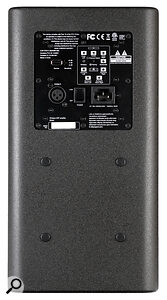Mesanovic’s three‑way speaker offers outstanding performance, wireless connectivity — and a cardioid bass response.
I reviewed boutique US microphone manufacturers Mesanovic’s first foray into monitor manufacture, the RTM10, back in SOS July 2021. In the spotlight this month is the company’s second monitoring product, the CDM65. And, ignoring the fact that all moving‑coil speakers are conceptually similar, the CDM65 and RTM10 are like chalk and cliché. I say this because whereas the RTM10 has just an analogue input, the CDM65 adds the WiSA HT wireless audio protocol and all the streaming options that this technology makes possible. And where the RTM10 incorporates an in‑house developed and manufactured ribbon tweeter, the CDM65 employs a considerably more conventional OEM device. There’s more differentiation, too, because where the RTM10 is an entirely conventional two‑way direct‑radiating loudspeaker with acoustic dispersion defined by its drivers and enclosure dimensions, the three‑way CDM65 features Kii Three‑style active cardioid radiation, enabled by its side‑mounted drivers functioning as both low‑frequency radiators and low‑midrange dispersion modifiers. So, not only is the CDM65 not much like its Mesanovic sibling, it’s a pretty unusual monitor full stop.
Sizing Up
On arrival, the CDM65 turned out to be more compact than I had anticipated. This is a good thing, and means not only that the CDM65 fits easily into a nearfield installation (although bear in mind that side‑firing drivers need a little space to breathe), but also that it’s potentially suited to immersive multi‑channel installations — tapped inserts on its back panel enable the attachment of VESA standard mounting brackets. Compact does not mean lightweight, though, and at 14.5kg, the CDM65 is still a significant lift on to the monitor shelf. The CDM65 cabinet itself is a slim, rounded‑corner, wood‑based design finished in a textured dark grey paint. It’s the kind of utilitarian paint finish that is both relatively inexpensive to apply and good at hiding material flaws. But, given that the CDM65’s wireless functionality seems intended to fit it for consumer as well as professional markets, I wonder if it looks classy enough. Time, and customers, I guess, will tell.
 As well as featuring an analogue XLR input, the CDM65 can be used wirelessly as part of a WiSA network in configurations up to 7.1 surround.The CDM65’s active electronics comprise Class‑D amplification rated at 150 Watts each for the midrange driver and tweeter, and 300 Watts for the twin bass drivers. Being a wireless‑capable monitor, the signal flow is digital throughout and capable of up to 96kHz/24‑bit sampling rate and word length. Around the back is a configuration and connection panel that offers a power switch, a balanced XLR analogue input, a wireless pairing button, an input sensitivity switch (+6dB, 0dB, ‑6dB) and a USB socket for firmware updates. To switch the CDM65 between its default cardioid‑bass mode and ‘standard’ mode, you need to load alternative firmware from a USB pen drive. A schematic shows a 7.1 speaker system with LED indication that’s used to specify the role of the specific CDM65 in a wireless multi‑channel system. I’ll describe the WiSA HT wireless and multi‑channel capabilities more fully in the ‘Without Wires’ box.
As well as featuring an analogue XLR input, the CDM65 can be used wirelessly as part of a WiSA network in configurations up to 7.1 surround.The CDM65’s active electronics comprise Class‑D amplification rated at 150 Watts each for the midrange driver and tweeter, and 300 Watts for the twin bass drivers. Being a wireless‑capable monitor, the signal flow is digital throughout and capable of up to 96kHz/24‑bit sampling rate and word length. Around the back is a configuration and connection panel that offers a power switch, a balanced XLR analogue input, a wireless pairing button, an input sensitivity switch (+6dB, 0dB, ‑6dB) and a USB socket for firmware updates. To switch the CDM65 between its default cardioid‑bass mode and ‘standard’ mode, you need to load alternative firmware from a USB pen drive. A schematic shows a 7.1 speaker system with LED indication that’s used to specify the role of the specific CDM65 in a wireless multi‑channel system. I’ll describe the WiSA HT wireless and multi‑channel capabilities more fully in the ‘Without Wires’ box.
Driving Force
In terms of its electro‑acoustic architecture, the CDM65 is a three‑way system with four drivers: a waveguide‑loaded 25mm tweeter, a 130mm midrange driver and two 165mm side‑mounted bass drivers. Rather than being built in‑house at Mesanovic, as is the tweeter used in the RTM10, all of the CDM65 drivers are OEM devices, although the tweeter employs a Mesanovic‑designed and manufactured waveguide. Said waveguide is CNC machined from solid aluminium and carries a high‑quality anodised finish. The aluminium‑diaphragm midrange driver appears to be the same as, or at least very closely related to, the one used in the RTM10. It incorporates specific features within its motor system (the voice coil, magnet and associated metalwork) designed to counter some of the distortion‑producing mechanisms inherent to moving‑coil drivers, and over the decades I’ve come to realise just how significant these kinds of features are. This bodes well. More generally, the CDM65 midrange driver is one I already know to be of very high performance, both objectively and subjectively.
The side‑mounted bass drivers are Kevlar‑reinforced paper‑diaphragm devices, engineered specifically for their low‑frequency role, with four‑layer voice‑coil...
You are reading one of the locked Subscribers-only articles from our latest 5 issues.
You've read 30% of this article for free, so to continue reading...
- ✅ Log in - if you have a Subscription you bought from SOS.
- Buy & Download this Single Article in PDF format £1.00 GBP$1.49 USD
For less than the price of a coffee, buy now and immediately download to your computer or smartphone.
- Buy & Download the FULL ISSUE PDF
Our 'full SOS magazine' for smartphone/tablet/computer. More info...
- Buy a DIGITAL subscription (or Print + Digital)
Instantly unlock ALL premium web articles! Visit our ShopStore.


